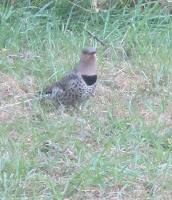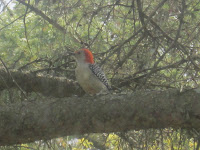Using the Handbook of Nature Study as well as the Outdoor Hour Challenge about red birds, I shared the following information with Sophia and Olivia:
Robins
=> A few robins can find food to nourish them during the northern winter, but for the most part they go in flocks to the southern states where they live mostly upon fruits and berries.
The first robin of the season in the apple tree.
(Taken on March 21, 2008.)
=> They do not nest or sing when the live in the South.
=> Father robin is more bold in his color than his mate. His beak is yellow, there is a yellow ring about the eye, and a white spot above it.
=> Mother robin has a paler back and breast and no black upon the head.
=> The songs are best heard in the early dawn and in the evening.
=> The robin's nest has a lot of strong grass, fine straw, leaves, and rootlets. The female bird will use soft mud to create the nest, and then molds it to her body by turning around and around.
Robin bringing materials back to her nest.
(Taken on April 22, 2011.)
=> Both parents share the monotonous business of incubating.
Robin sitting in the nest in the oak tree.
(Taken on April 30, 2011.)
=> Young robins eat about 68 earthworms daily. If the worms were laid end to end it would measure 14 feet.
=> The young birds' eyes open when they are 6-8 days old.
=> At 11 days, they are pretty well feathered.
A juvenile robin we saw in South Dakota.
(Taken on June 9, 2012.)
=> Robins don't sing much after the breeding season is over until after they have molted.
=> They are fond of cherries and other pulp fruit.
=> The chief enemies are cats, crows, and squirrels.
Cardinals
=> The cardinal gets its name from the dress of a high functionary of the church.
=> Its beak is thick and large. It also is red in color - a rarity in beak color. It is framed in black feathers which makes its beak stand out more.
=> The beak is so strong it can crush the hardest of seed shells or driest of grains.
=> The cardinal is smaller than robin.
=> The only bird that rivals the cardinal in redness is the scarlet tanager which has black wings.
=> The crest is useful in expressing emotions. When all is serene, it lies back flat on the head. However, if there's any excitement - joy, surprise, or anger - it lifts until it is peaked as an old-fashioned nightcap.
The cardinal with a black-capped chickadee at one of the feeders here.
(Taken on February 22, 2011.)
=> Both the males and females sing. Most female birds don't sing, so this is an unusual trait of the female cardinal.
=> The nest is built in bushes, vines, or low trees. The nest rarely goes more than 6-8 feet above the ground; and is well-hidden wherever it is located.
=> The nest is made from weed stems, tendrils, twigs, bark of the grapevine, and coarse grass. It is lined with fine grass and rootlets.
=> Three or four eggs are laid; and they are bluish white or grayish with dull, brown marks.
=> Father cardinal is an exemplary husband and father. He care for and feeds his mate tenderly and sings to her gloriously while she is sitting; and he works hard catching insects for the nestlings.
=> The male cardinal also is a brave defender of his nest and will attack any intruder, however, large, with undaunted courage.
=> While the female bird is hatching the second brood, the father keeps the first brood with him and cares for them. Often the whole family remains together during the winter, making a small flock.
=> The food consists of weed seeds, corn, wheat, oats, grasshoppers, beetles, and flies. They also will eat garden and wild berries.
A male cardinal with dark-eyed juncos eating some seeds.
(Taken on December 19, 2010.)
=> To get cardinals to visit, put some corn out on the ground. They actually prefer to stay in location for the summer and winter, so this will encourage them to stay in one spot.
Cardinals eating some seed we spread out on the snow in the backyard.
(Taken on December 11, 2010.)
House Finches
(These facts are from Wild Birds Unlimited since the Handbook for Nature Study didn't have a section about house finches.)
=>Male house finches display a wide variety of plumage coloration ranging from gray to bright crimson. The coloration comes from carotenoid pigments found in some wild foods. The more pigment present in the foods eaten when they are molting new feathers…the redder the male.
=> House finches roost at night in close proximity to each other. They sometimes huddle together for warmth; and often repeatedly use their favorite roosting spots.
House finch on a branch.
=> House finches like nectar and can become quite a nuisance at hummingbird feeders. If that happens, simply offer them a dish of nectar for their own use.
=> To attract house finches, provide a water source for them. They can drink up to 40% of their body weight on a hot summer day.
House finch at a hummingbird feeder.
=> House finches are almost vegetarian feeders. In fact, about 97% of their diet is made up of vegetable matter including buds, fruits, and seeds.
=> At feeders, where they can be frequently seen, they prefer small sunflower seeds.
=> House finches’ diets are the most vegetarian of any North American bird. Unlike most other seed eating birds, finches don't switch to eating insects during the summer nesting season. They continue to eat mostly seeds. That being said, when insects are abundant, they will eat some of them.
=> House finches rarely use bird houses to build their nest in. Rather, they prefer ledge, coniferous trees, street lamps, hanging planters, and ivy on buildings.
=> House finches generally produce at least two broods each nesting season.
=> A few female house finches have laid a second clutch of eggs several days before fledging their young from a previous brood. This may be due to the male bird's predominant role in raising the young from the earlier nest.
Outdoor Hour Time
We went outside for about 20 minutes to see if we could find any robins, cardinals, and/or house finches. While we were outside, we also filled the bird feeders.
Sophia and Olivia filling a bird feeder.
(Taken on September 21, 2012.)
The only birds we saw when we were outside were black-capped chickadees who seemed very interested in watching us fill the feeders. They flew to branches and watched us for awhile, and then flew off and would sing in a nearby tree.
Nature Journal
The girls each did an entry in their nature journals about red birds.
Sophia's nature journal.
She has her own 8 1/2" x 11" spiral-bound notebook.
The pages are all white so she can draw, glue images in it, or
include nature photographs she has taken.
They each wrote key facts they wanted to remember about cardinals, robins, finches, and/or red-bellied woodpeckers. The images are from magazine clippings I had accumulated throughout the years.
Olivia's nature journal entry about red birds.
She included three images - two of cardinals and one of a robin.
She also liked the poem about cardinals.
Olivia also has her own 8 1/2" x 11" blank book
for her nature journal.
Bird Observations while Baking Peach Pies
After we came back inside and worked on our nature journal; we began working in the kitchen making miniature peach pies. Within a few minutes Sophia said, "Mom! There's a robin at bird bath." Sure enough, there it was drinking some water.
Robin on the edge of the bird bath and
two northern flickers on the ground.
Not more than a minute later, a couple of northern flickers flew and landed by the bird feeders and bath.
A northern flicker in the backyard.
Within five minutes, Sophia said, "Did you see that? A huge pileated woodpecker just flew by!" She went to the family room and out that window is a big feeder. Sitting right on top of it was the pileated woodpecker. Needless to say, she was very excited. (I wasn't quick enough to get a picture of it, unfortunately.)
We also saw another bird that has been visiting us often over the past week: a red-bellied woodpecker. It has been enjoying eating from the hummingbird feeder...of all places.
A red-bellied woodpecker in the pine tree.
A blue jay sitting on top of the bird bath.
There was even a flock of mourning doves in the driveway. Normally we only see two at a time...never eight!
Mourning doves in the driveway.
Just as we were finishing our work in the kitchen, a bright red male cardinal showed up in the apple tree.
Cardinal hiding in the tree.
All in all, it has been a fun afternoon watching the many birds who ate at the feeders and drank water or took a bath in the bird bath.










1 comment:
So many red birds! What a wonderful time you had observing and studying your local red birds. Thank you so much for sharing your experiences with the OHC Blog Carnival.
Post a Comment